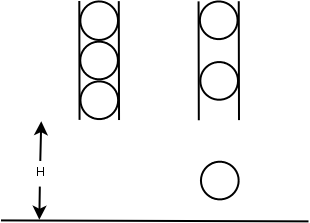| Time Limit: 1000MS | Memory Limit: 65536K | |||
| Total Submissions: 784 | Accepted: 266 | Special Judge | ||
Description
Simon is doing a physics experiment with N identical balls with the same radius of R centimeters. Before the experiment, all N balls are fastened within a vertical tube one by one and the lowest point of the lowest ball is Hmeters above the ground. At beginning of the experiment, (at second 0), the first ball is released and falls down due to the gravity. After that, the balls are released one by one in every second until all balls have been released. When a ball hits the ground, it will bounce back with the same speed as it hits the ground. When two balls hit each other, they with exchange their velocities (both speed and direction).

Simon wants to know where are the N balls after T seconds. Can you help him?
In this problem, you can assume that the gravity is constant: g = 10 m/s2.
Input
The first line of the input contains one integer C (C ≤ 20) indicating the number of test cases. Each of the following lines contains four integers N, H, R, T.
1≤ N ≤ 100.
1≤ H ≤ 10000
1≤ R ≤ 100
1≤ T ≤ 10000
Output
For each test case, your program should output N real numbers indicating the height in meters of the lowest point of each ball separated by a single space in a single line. Each number should be rounded to 2 digit after the decimal point.
Sample Input
2 1 10 10 100 2 10 10 100
Sample Output
4.95 4.95 10.20
Source
#include <iostream> #include <cstdio> #include <cstring> #include <algorithm> #include <cmath> using namespace std; const int MAX = 105; const double g = 10.0; int N,H,R,T; double y[MAX]; double cal(int T) { if(T < 0) return H; double t = sqrt(2 * H / g); int k = (int) T / t; if(k % 2 == 0) { double d = T - k * t; return H - g * d * d / 2; } else { double d = k * t + t - T; return H - g * d * d / 2; } } void solve() { for(int i = 0; i < N; ++i) { y[i] = cal(T - i); } sort(y ,y + N); for(int i = 0; i < N; ++i) { printf("%.2f%c",y[i] + 2 * R * i / 100.0,i + 1 == N ? ' ' : ' '); } } int main() { int C; //freopen("sw.in","r",stdin); scanf("%d",&C); while(C--) { scanf("%d%d%d%d",&N,&H,&R,&T); solve(); } // cout << "Hello world!" << endl; return 0; }